
Ivan Rusachek
Adam and Eve
Etching
The story of Adam and Eve in the Garden of Eden, recorded in the second and third chapters of Genesis, is an archetype of Western art, lending itself to multiple interpretations both sacred and profane. Artists in the pre-modern era worked within recognized theological boundaries, when they depicted our primal parents in their naked innocence. You sometimes get the feeling the story of Adam and Eve served them as a pretext for making erotic art, but the Angel of the Flaming Sword, barring a return to Paradise, also figured in their imagery of this primal tale of human beginnings. In an era when original sin is more of a taboo topic than sex, there are voyeuristic art works of Adam and Eve to be found in plenty (especially among small format book plate makers). The real challenge for contemporary artists is dealing with the "sin component" of the Genesis story. Belarus Printmaker Ivan Rusachek offers a darkly rich rendering of lost innocence in his book plate etching, Adam and Eve. There is no sign of life in this defoliated garden of intensely incised lines, except for the joined figures of our primal parents whose posture mimics the trunk of a tree, perhaps, the very one from which they have stolen the forbidden fruit of the Knowledge of Good and Evil. These fallen humans do not hide their newly-discovered bodies from the all-seeing eyes of their Creator God. It is their faces they conceal in shrubbery in a futile attempt at anonymity. Adam's genitals are not hidden by fig-leaves but the kind of black boxing, which conceals private parts in censored pornographic photographs. Despair seems to coat his body like a free floating glob from an oil slick. With hands flung outward, the First Adam assumes a cruciform shape, suggesting the outstretched arms of Christ on the Cross, the Second Adam who will come to redeem fallen humankind. Rusachek has created a haunting image of how we came to find ourselves East of Eden. (John Kohan)
